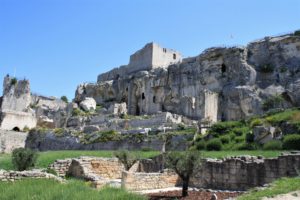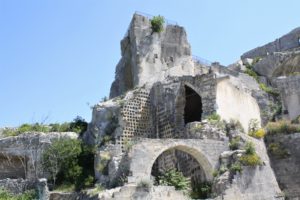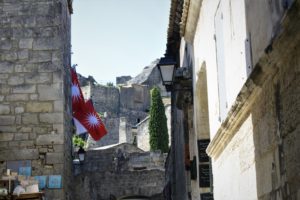Carrieres de Lumineres
When visiting the village of Les Baux-de-Provence, we were told to visit the old quarry. “Go to the light show. It is in the old quarry. You’ll see Picassos there. It is amazing.”

A light show in an old quarry? With Picassos? Sure. It’s probably worth seeing what it is.
Expecting some drawings on the quarry walls, lit with spotlights, we made our way out of the village, down the road, to the old quarry. I’m sure we were thinking this would be underwhelming…at best.
Well…first of all, it was not what we were expecting.

Yes. It was an old quarry. Old being the operative word.
The quarry was where the Les Baux stone was extracted. This stone from the south of France is slightly calcareous limestone, fine-grained, whiteish in color. It results from the compaction of calcium carbonate on calcareous sand. Marine fossils have been found in the rock.
The quarry was dampish and coolish. And, huge.
Back in the 19th century, this stone was in demand for building. Hence, the enlarging of the quarry to meet those demands. At the time the quarry was referred to as Les Grands Fonds. Today it is called Les Carrieres de Lumieres.

Following WWI, the demands lessened so much that the quarry was closed until about 1959. A visionary genius, Jean Cocteau, loved the beauty and simplicity of the old quarry. He filmed The Testament of Orpheus here.
In 1977 Joseph Svoboda, a scenographer, decided the walls would make a great backdrop for a light and sound show. Since then, the management developed a unique concept for the site. AMIEX is a registered name, Art & Music Immersive Experience.
Now, music and art come together on the walls of this massive place. Monet, Renoir, Chagall, Klimt, Vienna, Michelangelo, de Vinci, Raphael, Bosch, Brueghel, Arcimboldo have all been showcased.
A light show? Oh my. That doesn’t even begin to describe it.
We stepped inside a basically dark cavernous space and were met with the Flower Power movement, Sixties Music, Hippies, Peace and Love, Sgt. Pepper, Hendrix, the Stones, the Beach Boys. Each song accompanied by swirling lights, flashing colors, and dancing people. All displayed on the walls and floor of the quarry. Talk about a party.
If you’re prone to motion sickness, don’t look down at the floor. It’s moving. I think.

When this journey ended, the lights softly came on. We could see how huge this place is and the white quarry walls with their marks where immense blocks of limestone had been cut out years ago. As the lights once again dimmed, we were taken through a journey of the Spanish masters’ paintings. All projected on the walls. Some were shown straight ahead. Some moved around the walls and corners, from one wall to the next. Music played. Goya was there. So were Rusinol, Zuloaga, Sorolla.
Then followed Picasso. The entire experience was an intense lesson in discovering a century of Spanish painting. All up close and personal. All bigger than big. Portraits, beach scenes, rustic, gardens…all brought to life right in front of us.
Once the lights came back up, we wandered around the monumental space of the quarry. It was impressive, even without the light show.
How did they do it? The digital and immersive exhibitions are presented with thousands of moving images of digitized works. They are brought to life by the cutting edge of AMIEX technical equipment.
Those white limestone walls are the perfect background for the hundred projectors to transform the masterpieces. Or the Sixties.
Again…not just some light show. Not just a few paintings.
You have to go…trust me.
If You Go: Carrieres de Lumieres is located at Route de Maillane 13520 Les Baux-de-Provence. It is 800 m from the Chateau des Baux-de-Provence.



